2015 BMW 650I COUPE belt
[x] Cancel search: beltPage 131 of 251
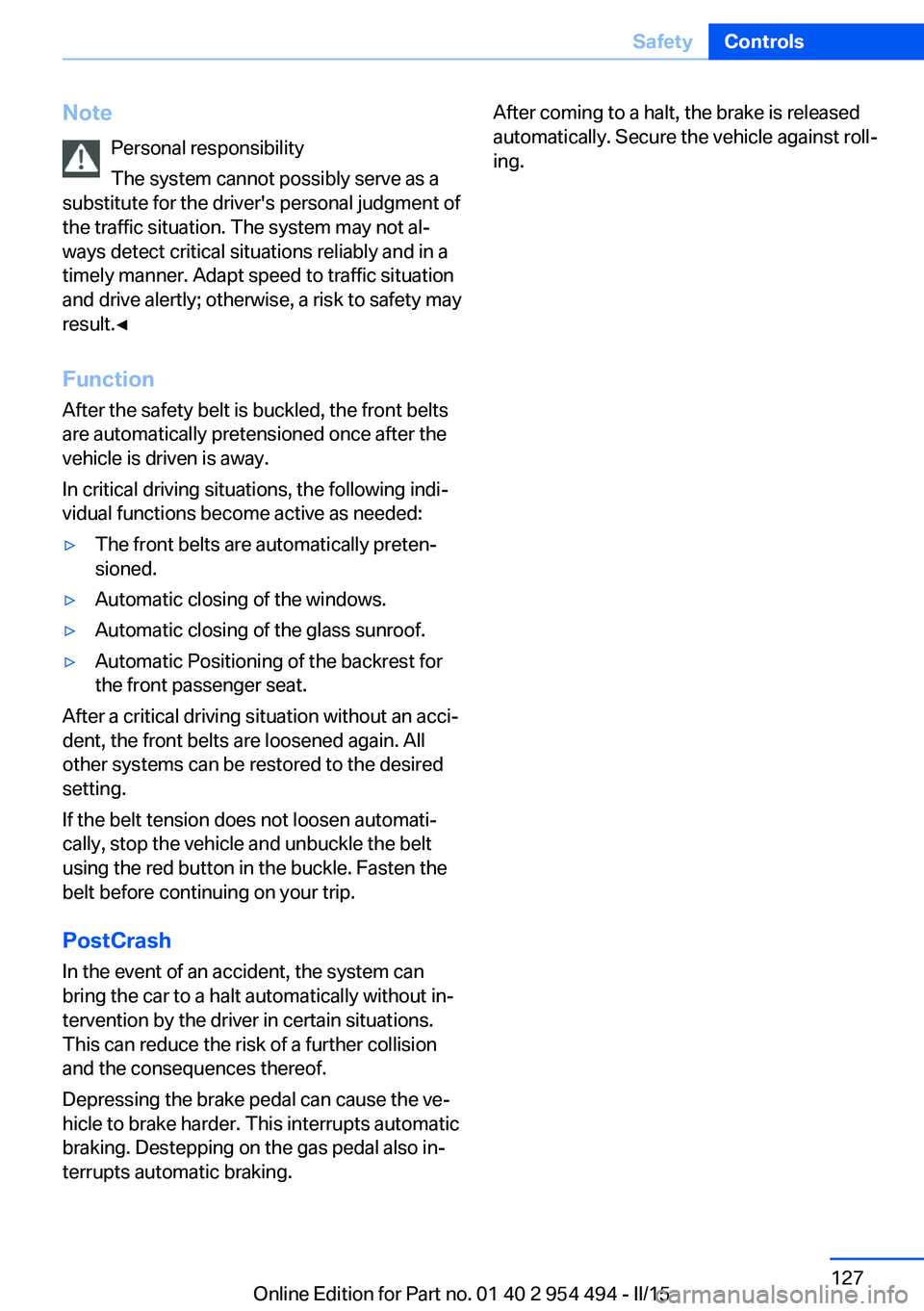
NotePersonal responsibility
The system cannot possibly serve as a
substitute for the driver's personal judgment of
the traffic situation. The system may not al‐
ways detect critical situations reliably and in a
timely manner. Adapt speed to traffic situation
and drive alertly; otherwise, a risk to safety may
result.◀
Function
After the safety belt is buckled, the front belts
are automatically pretensioned once after the
vehicle is driven is away.
In critical driving situations, the following indi‐
vidual functions become active as needed:▷The front belts are automatically preten‐
sioned.▷Automatic closing of the windows.▷Automatic closing of the glass sunroof.▷Automatic Positioning of the backrest for
the front passenger seat.
After a critical driving situation without an acci‐
dent, the front belts are loosened again. All
other systems can be restored to the desired
setting.
If the belt tension does not loosen automati‐
cally, stop the vehicle and unbuckle the belt
using the red button in the buckle. Fasten the
belt before continuing on your trip.
PostCrash
In the event of an accident, the system can
bring the car to a halt automatically without in‐
tervention by the driver in certain situations.
This can reduce the risk of a further collision
and the consequences thereof.
Depressing the brake pedal can cause the ve‐
hicle to brake harder. This interrupts automatic
braking. Destepping on the gas pedal also in‐ terrupts automatic braking.
After coming to a halt, the brake is released
automatically. Secure the vehicle against roll‐
ing.Seite 127SafetyControls127
Online Edition for Part no. 01 40 2 954 494 - II/15
Page 142 of 251
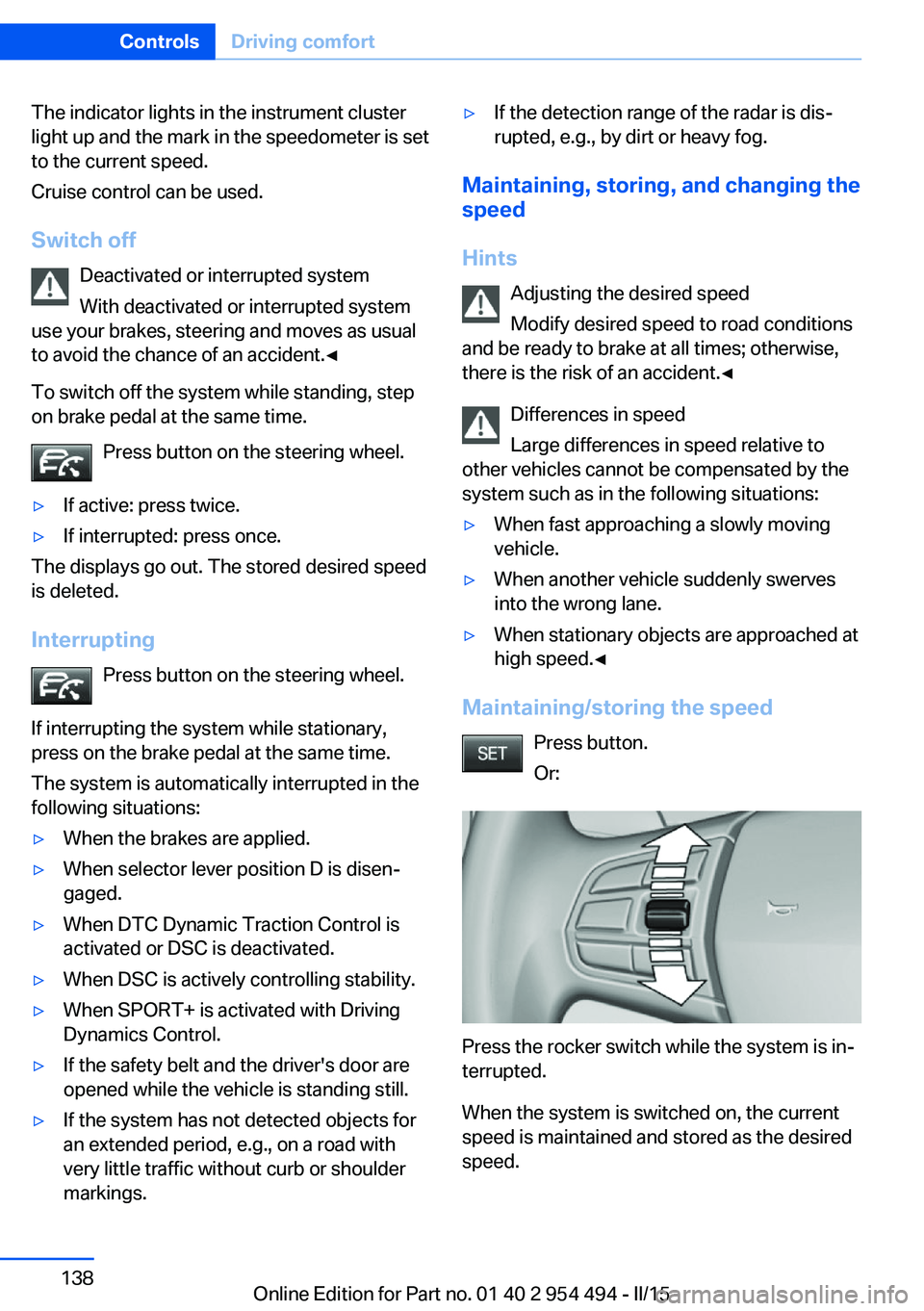
The indicator lights in the instrument cluster
light up and the mark in the speedometer is set
to the current speed.
Cruise control can be used.
Switch off Deactivated or interrupted system
With deactivated or interrupted system
use your brakes, steering and moves as usual
to avoid the chance of an accident.◀
To switch off the system while standing, step
on brake pedal at the same time.
Press button on the steering wheel.▷If active: press twice.▷If interrupted: press once.
The displays go out. The stored desired speed
is deleted.
Interrupting Press button on the steering wheel.
If interrupting the system while stationary,
press on the brake pedal at the same time.
The system is automatically interrupted in the
following situations:
▷When the brakes are applied.▷When selector lever position D is disen‐
gaged.▷When DTC Dynamic Traction Control is
activated or DSC is deactivated.▷When DSC is actively controlling stability.▷When SPORT+ is activated with Driving
Dynamics Control.▷If the safety belt and the driver's door are
opened while the vehicle is standing still.▷If the system has not detected objects for
an extended period, e.g., on a road with
very little traffic without curb or shoulder
markings.▷If the detection range of the radar is dis‐
rupted, e.g., by dirt or heavy fog.
Maintaining, storing, and changing the
speed
Hints Adjusting the desired speedModify desired speed to road conditions
and be ready to brake at all times; otherwise,
there is the risk of an accident.◀
Differences in speed
Large differences in speed relative to
other vehicles cannot be compensated by the
system such as in the following situations:
▷When fast approaching a slowly moving
vehicle.▷When another vehicle suddenly swerves
into the wrong lane.▷When stationary objects are approached at
high speed.◀
Maintaining/storing the speed
Press button.
Or:
Press the rocker switch while the system is in‐
terrupted.
When the system is switched on, the current
speed is maintained and stored as the desired
speed.
Seite 138ControlsDriving comfort138
Online Edition for Part no. 01 40 2 954 494 - II/15
Page 182 of 251
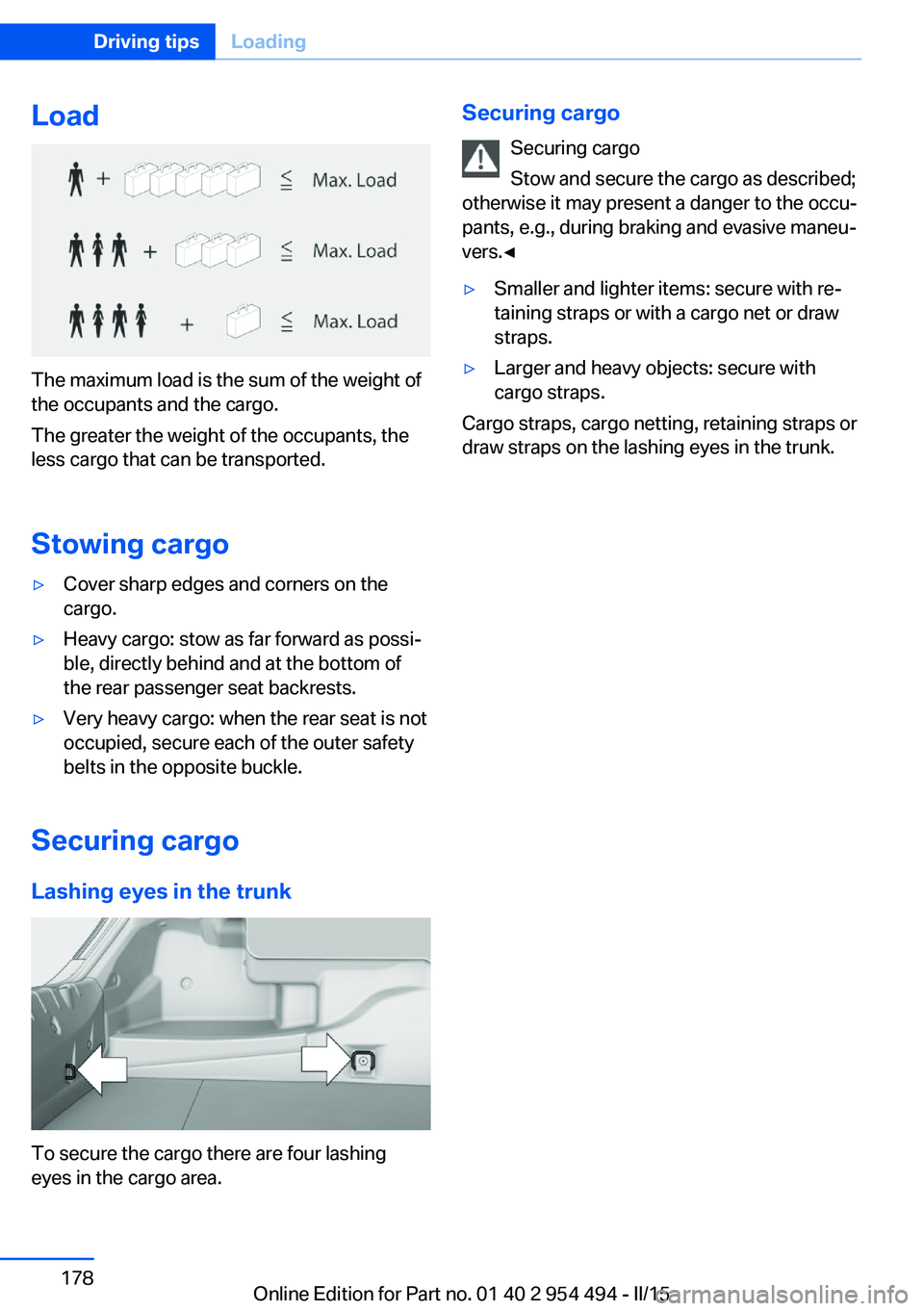
Load
The maximum load is the sum of the weight of
the occupants and the cargo.
The greater the weight of the occupants, the
less cargo that can be transported.
Stowing cargo
▷Cover sharp edges and corners on the
cargo.▷Heavy cargo: stow as far forward as possi‐
ble, directly behind and at the bottom of
the rear passenger seat backrests.▷Very heavy cargo: when the rear seat is not
occupied, secure each of the outer safety
belts in the opposite buckle.
Securing cargo
Lashing eyes in the trunk
To secure the cargo there are four lashing
eyes in the cargo area.
Securing cargo
Securing cargo
Stow and secure the cargo as described;
otherwise it may present a danger to the occu‐
pants, e.g., during braking and evasive maneu‐
vers.◀▷Smaller and lighter items: secure with re‐
taining straps or with a cargo net or draw
straps.▷Larger and heavy objects: secure with
cargo straps.
Cargo straps, cargo netting, retaining straps or
draw straps on the lashing eyes in the trunk.
Seite 178Driving tipsLoading178
Online Edition for Part no. 01 40 2 954 494 - II/15
Page 233 of 251
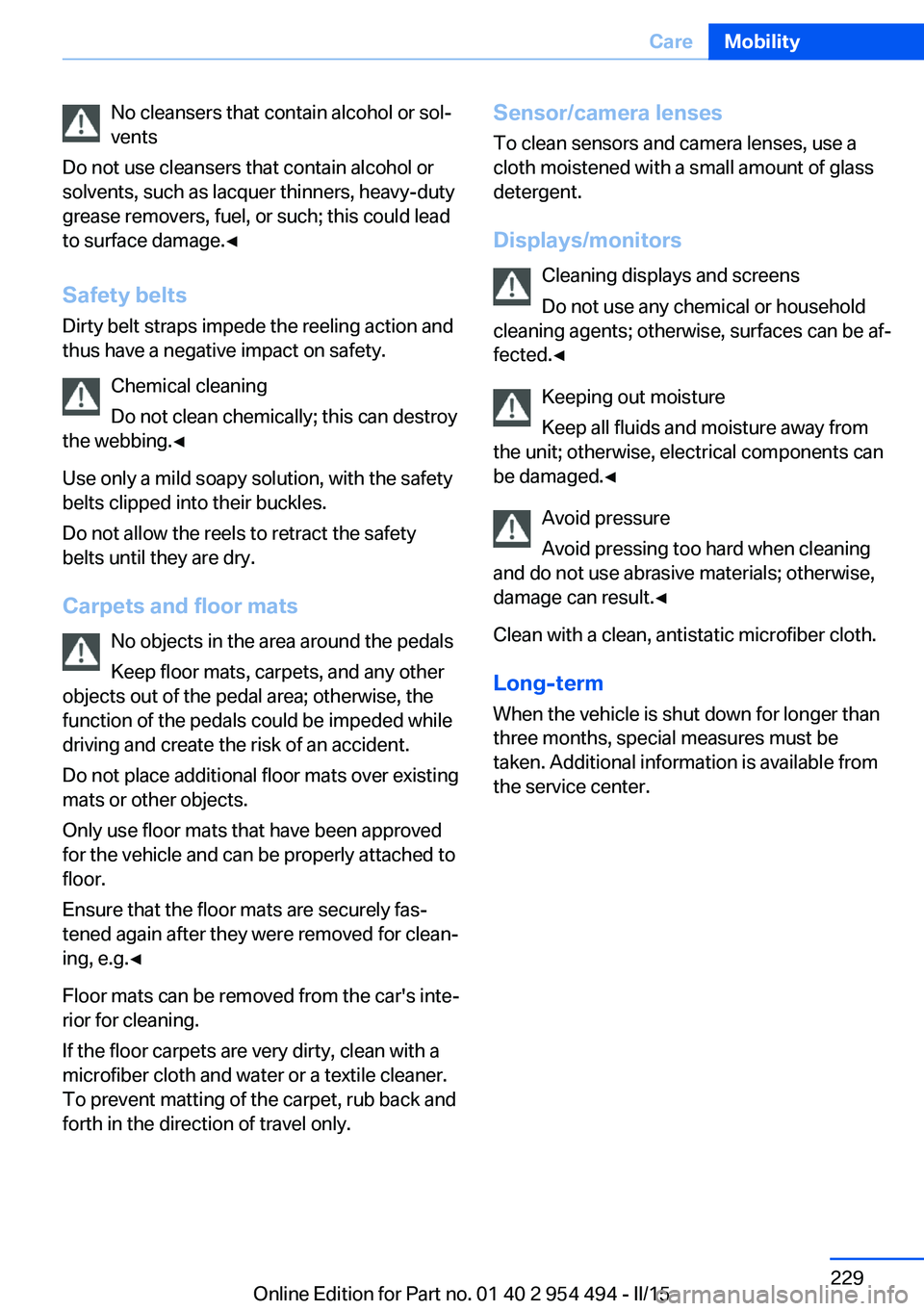
No cleansers that contain alcohol or sol‐
vents
Do not use cleansers that contain alcohol or
solvents, such as lacquer thinners, heavy-duty
grease removers, fuel, or such; this could lead
to surface damage.◀
Safety belts
Dirty belt straps impede the reeling action and
thus have a negative impact on safety.
Chemical cleaning
Do not clean chemically; this can destroy
the webbing.◀
Use only a mild soapy solution, with the safety
belts clipped into their buckles.
Do not allow the reels to retract the safety
belts until they are dry.
Carpets and floor mats No objects in the area around the pedals
Keep floor mats, carpets, and any other
objects out of the pedal area; otherwise, the
function of the pedals could be impeded while
driving and create the risk of an accident.
Do not place additional floor mats over existing
mats or other objects.
Only use floor mats that have been approved
for the vehicle and can be properly attached to
floor.
Ensure that the floor mats are securely fas‐
tened again after they were removed for clean‐
ing, e.g.◀
Floor mats can be removed from the car's inte‐
rior for cleaning.
If the floor carpets are very dirty, clean with a
microfiber cloth and water or a textile cleaner.
To prevent matting of the carpet, rub back and
forth in the direction of travel only.Sensor/camera lenses
To clean sensors and camera lenses, use a
cloth moistened with a small amount of glass
detergent.
Displays/monitors Cleaning displays and screens
Do not use any chemical or household
cleaning agents; otherwise, surfaces can be af‐
fected.◀
Keeping out moisture
Keep all fluids and moisture away from
the unit; otherwise, electrical components can
be damaged.◀
Avoid pressure
Avoid pressing too hard when cleaning
and do not use abrasive materials; otherwise,
damage can result.◀
Clean with a clean, antistatic microfiber cloth.
Long-termWhen the vehicle is shut down for longer than
three months, special measures must be
taken. Additional information is available from
the service center.Seite 229CareMobility229
Online Edition for Part no. 01 40 2 954 494 - II/15
Page 240 of 251
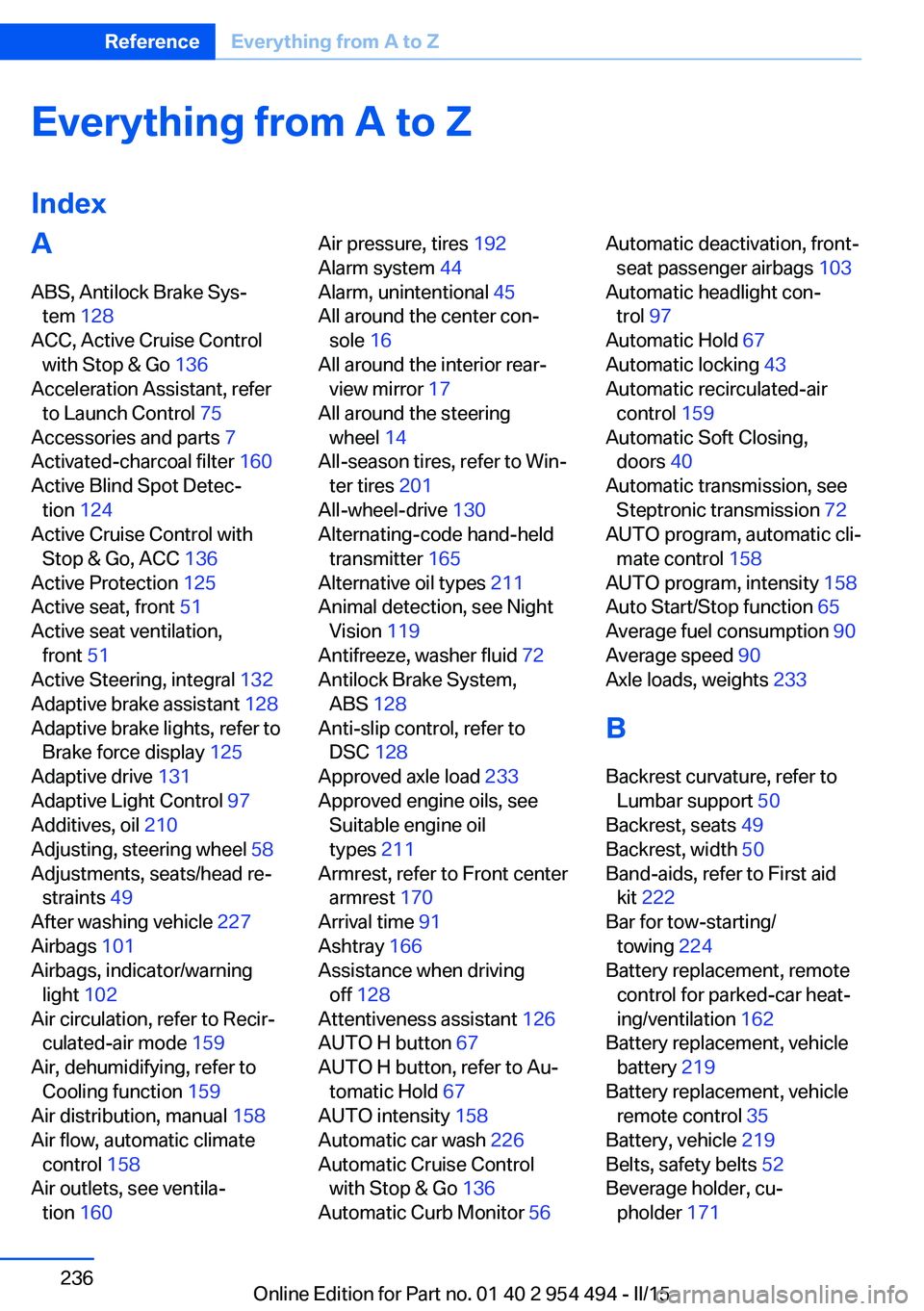
Everything from A to Z
IndexA ABS, Antilock Brake Sys‐ tem 128
ACC, Active Cruise Control with Stop & Go 136
Acceleration Assistant, refer to Launch Control 75
Accessories and parts 7
Activated-charcoal filter 160
Active Blind Spot Detec‐ tion 124
Active Cruise Control with Stop & Go, ACC 136
Active Protection 125
Active seat, front 51
Active seat ventilation, front 51
Active Steering, integral 132
Adaptive brake assistant 128
Adaptive brake lights, refer to Brake force display 125
Adaptive drive 131
Adaptive Light Control 97
Additives, oil 210
Adjusting, steering wheel 58
Adjustments, seats/head re‐ straints 49
After washing vehicle 227
Airbags 101
Airbags, indicator/warning light 102
Air circulation, refer to Recir‐ culated-air mode 159
Air, dehumidifying, refer to Cooling function 159
Air distribution, manual 158
Air flow, automatic climate control 158
Air outlets, see ventila‐ tion 160 Air pressure, tires 192
Alarm system 44
Alarm, unintentional 45
All around the center con‐ sole 16
All around the interior rear‐ view mirror 17
All around the steering wheel 14
All-season tires, refer to Win‐ ter tires 201
All-wheel-drive 130
Alternating-code hand-held transmitter 165
Alternative oil types 211
Animal detection, see Night Vision 119
Antifreeze, washer fluid 72
Antilock Brake System, ABS 128
Anti-slip control, refer to DSC 128
Approved axle load 233
Approved engine oils, see Suitable engine oil
types 211
Armrest, refer to Front center armrest 170
Arrival time 91
Ashtray 166
Assistance when driving off 128
Attentiveness assistant 126
AUTO H button 67
AUTO H button, refer to Au‐ tomatic Hold 67
AUTO intensity 158
Automatic car wash 226
Automatic Cruise Control with Stop & Go 136
Automatic Curb Monitor 56 Automatic deactivation, front-
seat passenger airbags 103
Automatic headlight con‐ trol 97
Automatic Hold 67
Automatic locking 43
Automatic recirculated-air control 159
Automatic Soft Closing, doors 40
Automatic transmission, see Steptronic transmission 72
AUTO program, automatic cli‐ mate control 158
AUTO program, intensity 158
Auto Start/Stop function 65
Average fuel consumption 90
Average speed 90
Axle loads, weights 233
B Backrest curvature, refer to Lumbar support 50
Backrest, seats 49
Backrest, width 50
Band-aids, refer to First aid kit 222
Bar for tow-starting/ towing 224
Battery replacement, remote control for parked-car heat‐
ing/ventilation 162
Battery replacement, vehicle battery 219
Battery replacement, vehicle remote control 35
Battery, vehicle 219
Belts, safety belts 52
Beverage holder, cu‐ pholder 171 Seite 236ReferenceEverything from A to Z236
Online Edition for Part no. 01 40 2 954 494 - II/15
Page 247 of 251
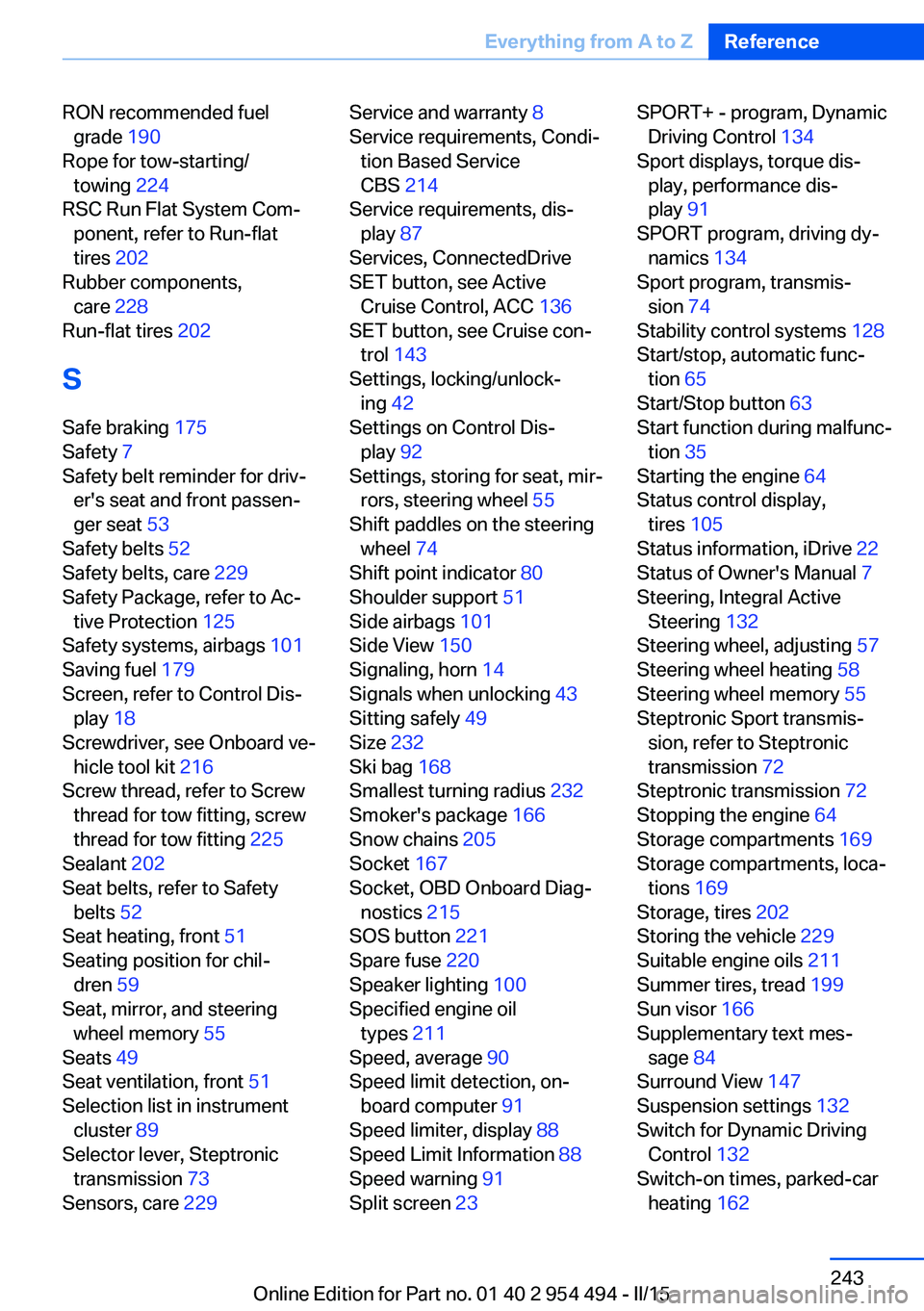
RON recommended fuelgrade 190
Rope for tow-starting/ towing 224
RSC Run Flat System Com‐ ponent, refer to Run-flat
tires 202
Rubber components, care 228
Run-flat tires 202
S Safe braking 175
Safety 7
Safety belt reminder for driv‐ er's seat and front passen‐
ger seat 53
Safety belts 52
Safety belts, care 229
Safety Package, refer to Ac‐ tive Protection 125
Safety systems, airbags 101
Saving fuel 179
Screen, refer to Control Dis‐ play 18
Screwdriver, see Onboard ve‐ hicle tool kit 216
Screw thread, refer to Screw thread for tow fitting, screw
thread for tow fitting 225
Sealant 202
Seat belts, refer to Safety belts 52
Seat heating, front 51
Seating position for chil‐ dren 59
Seat, mirror, and steering wheel memory 55
Seats 49
Seat ventilation, front 51
Selection list in instrument cluster 89
Selector lever, Steptronic transmission 73
Sensors, care 229 Service and warranty 8
Service requirements, Condi‐ tion Based Service
CBS 214
Service requirements, dis‐ play 87
Services, ConnectedDrive
SET button, see Active Cruise Control, ACC 136
SET button, see Cruise con‐ trol 143
Settings, locking/unlock‐ ing 42
Settings on Control Dis‐ play 92
Settings, storing for seat, mir‐ rors, steering wheel 55
Shift paddles on the steering wheel 74
Shift point indicator 80
Shoulder support 51
Side airbags 101
Side View 150
Signaling, horn 14
Signals when unlocking 43
Sitting safely 49
Size 232
Ski bag 168
Smallest turning radius 232
Smoker's package 166
Snow chains 205
Socket 167
Socket, OBD Onboard Diag‐ nostics 215
SOS button 221
Spare fuse 220
Speaker lighting 100
Specified engine oil types 211
Speed, average 90
Speed limit detection, on- board computer 91
Speed limiter, display 88
Speed Limit Information 88
Speed warning 91
Split screen 23 SPORT+ - program, Dynamic
Driving Control 134
Sport displays, torque dis‐ play, performance dis‐
play 91
SPORT program, driving dy‐ namics 134
Sport program, transmis‐ sion 74
Stability control systems 128
Start/stop, automatic func‐ tion 65
Start/Stop button 63
Start function during malfunc‐ tion 35
Starting the engine 64
Status control display, tires 105
Status information, iDrive 22
Status of Owner's Manual 7
Steering, Integral Active Steering 132
Steering wheel, adjusting 57
Steering wheel heating 58
Steering wheel memory 55
Steptronic Sport transmis‐ sion, refer to Steptronic
transmission 72
Steptronic transmission 72
Stopping the engine 64
Storage compartments 169
Storage compartments, loca‐ tions 169
Storage, tires 202
Storing the vehicle 229
Suitable engine oils 211
Summer tires, tread 199
Sun visor 166
Supplementary text mes‐ sage 84
Surround View 147
Suspension settings 132
Switch for Dynamic Driving Control 132
Switch-on times, parked-car heating 162 Seite 243Everything from A to ZReference243
Online Edition for Part no. 01 40 2 954 494 - II/15